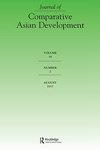马来西亚能源增长关系与环境库兹涅茨曲线假设:使用VECM和ARDL协整技术的实证分析
Q3 Social Sciences
引用次数: 0
摘要
本文以贸易开放和外国直接投资(FDI)的全球化变量和1997年亚洲金融危机的结构性断裂dummy为估计对象,考察了1971-2014年马来西亚的能源增长联系和环境库兹涅茨曲线(EKC)假设。为了给出干扰,在向量误差校正模型(VECM)和自回归分布滞后(ARDL)两种协整技术的框架下进行格兰杰因果检验。根据马来西亚的能源增长关系,参考两种方法的不同结果,我们得出结论,能源增长关系的存在在统计上得到了证实,但在该国尚未完全建立。另一方面,VECM和ARDL的结果都为马来西亚的EKC假设提供了相同的结论,即在初始阶段,随着经济增长越高,二氧化碳排放量越少,但在一个阈值之后,经济增长越高,二氧化碳排放量越多。本文章由计算机程序翻译,如有差异,请以英文原文为准。
Malaysia’s Energy-Growth Nexus and Environmental Kuznets Curve Hypothesis: Empirical Analysis Using the VECM and ARDL Cointegration Techniques
This paper investigated Malaysia’s energy-growth nexus and environmental Kuznets curve (EKC) hypothesis over the period 1971-2014 by taking the globalization variables of trade openness and foreign direct investment (FDI) and the structural break dummy of the Asian financial crisis of 1997 into estimation. To give interference, the Granger causality tests were implemented in the framework of two cointegration techniques: vector error correction model (VECM) and autoregressive distributed lag (ARDL). As per Malaysia’s energy-growth nexus, referring to different results of the two approaches, we concluded that the presence of the energy-growth nexus was statistically confirmed, but it has not been fully established yet in the country. On the other hand, both the VECM and ARDL results provided the same conclusion for Malaysia’s EKC hypothesis, that is, in the initial stage, as the higher economic growth, the less CO2 emissions, but after a threshold, the higher economic growth, the more CO2 emissions.
求助全文
通过发布文献求助,成功后即可免费获取论文全文。
去求助
来源期刊

Journal of Comparative Asian Development
Social Sciences-Political Science and International Relations
CiteScore
1.30
自引率
0.00%
发文量
2
期刊介绍:
The Journal of Comparative Asian Development (JCAD) aims to offer the most up-to-date research, analyses, and findings on the many aspects of social, economic, and political development in contemporary Asia conducted by scholars and experts from Asia and around the world.
 求助内容:
求助内容: 应助结果提醒方式:
应助结果提醒方式:


